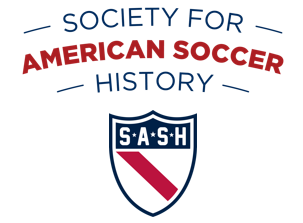This post reflects my own geographic bias. All of the stadiums I’m writing about here are located in the northeastern part of the country. I have lived 90 percent of my life in Pennsylvania and New York. The similarity of these two facts is not a coincidence.
All of the stadiums here meet, as far as I’m concerned, the definition of a soccer-specific stadium (or did). My definition is that the place should be shaped and used primarily for soccer, but that its use for other sports is OK. My view is that a soccer-specific stadium doesn’t have to be a soccer-exclusive stadium. The first stadium on this list, Steel Field, has also been used for baseball, football and track (and for one of the most grotesque “sports” events I’ve ever heard of, a contest among teams of Bethlehem Steel workers using their first-aid skills competitively in the face of simulated steel-mill catastrophes).
Steel Field in Bethlehem, Pa., is, I believe, the oldest still-standing soccer stadium in America, built in 1916. To call it a stadium is an exaggeration. It’s a grandstand, but a nice one. It holds 1,000 spectators, with a roof in case of rain and windows at the side to block the wind. It’s just right for its current use, as a small-college football stadium. It’s owned by Moravian College, which renovated it a few years ago. It looks very much the same as it did in 1916.
Metropolitan Oval in New York, near the border between Brooklyn and Queens, has often been referred to as the oldest continuously used soccer facility in the country, having been constructed in 1925. By the 1990s, it had fallen into disrepair, but it got a good renovation in 2001. It’s now the home field for several dozen amateur and college teams. It isn’t really a stadium, however. It’s a field, with bleachers that hold about 1,000 spectators. “Oval” was a common name for small soccer facilities in New York decades ago, but Met Oval is one of the last ones left.
Lusitano Stadium in Ludlow, Mass., which holds 3,000, has been in use for for soccer continuously since 1918, but in its earliest years it was just a field, without any stands. Its main occupant for many years was the semipro Ludlow Lusitano team, which played in the ASL for awhile.
Gaelic Park in New York, in the Bronx just across Broadway from Van Cortlandt Park, is only a year younger than Met Oval, but for many years it was used primarily for gaelic football and only occasionally for soccer. It now is owned by Manhattan College, was renovated in 2007, and is heavily used for college soccer.
Clark Field in East Newark, N.J., where the United States played Canada in 1885, is a place that today makes Steel Field and Met Oval look spectacular by comparison. It’s neither a grandstand nor a field. It’s a parking lot. It was used for semipro soccer games up to the 1940s, but the only thing about it that suggests soccer now is its rectangular shape.
Mark’s Stadium in North Tiverton, R.I., built in 1922 by Sam Mark for his ASL team, the Fall River Marksmen, is now a large empty field. The spot where the 15,000-capacity stadium once stood is next to the Bourne Mill, a former textile mill that has been converted into apartments. It’s less than 100 yards from the Rhode Island-Massachusetts state line, which is why Mark built his stadium there, so that Fall River fans could reach it but the Massachusetts blue laws wouldn’t stop him from charging admission on Sunday. The vague outline of the field is still visible in aerial photos.
Starlight Park in New York has probably been visited by more Big Soccer readers than any of the others here. They didn’t go there for soccer. They went there to drive from New Jersey to Long Island (or vice versa). Many things across the central Bronx were buried when the Cross-Bronx Expressway was built in the late 1950s, and Starlight Park, which had been home to several ASL teams and the site of numerous big games over the decades, was one of them.
A version of this article first appeared on Roger’s Big Soccer blog on Feb. 6, 2012.

In regard to soccer-specific stadiums on the West Coast, I believe that the first one (and probably the only one until recently) is the Boxer Stadium (formerly known as Balboa Park Soccer Stadium) in Balboa Park, San Francisco, California, paid for by the City and County of San Francisco, inaugurated in 1953.